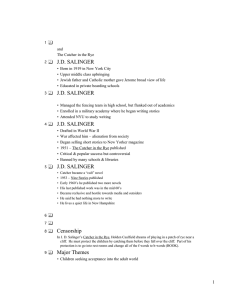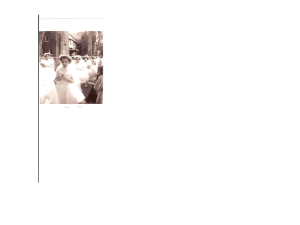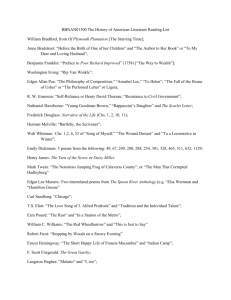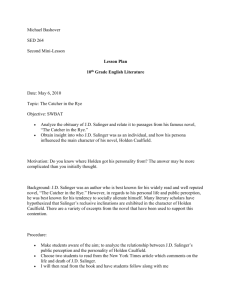"Salinger's Oasis of Innocence"
advertisement
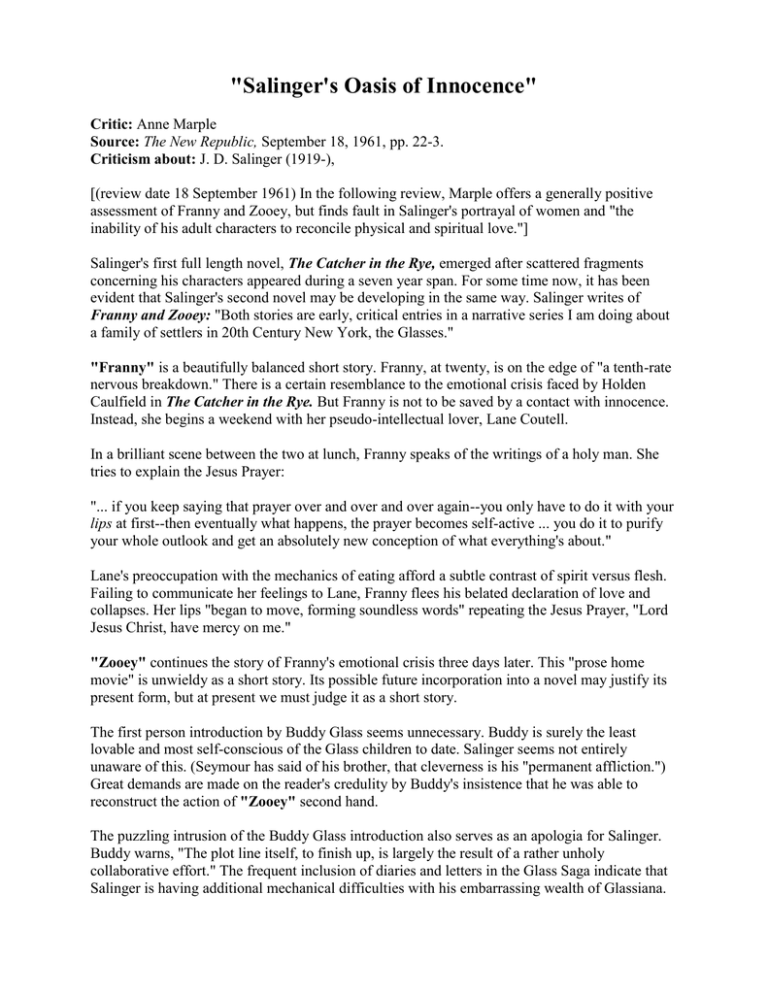
"Salinger's Oasis of Innocence" Critic: Anne Marple Source: The New Republic, September 18, 1961, pp. 22-3. Criticism about: J. D. Salinger (1919-), [(review date 18 September 1961) In the following review, Marple offers a generally positive assessment of Franny and Zooey, but finds fault in Salinger's portrayal of women and "the inability of his adult characters to reconcile physical and spiritual love."] Salinger's first full length novel, The Catcher in the Rye, emerged after scattered fragments concerning his characters appeared during a seven year span. For some time now, it has been evident that Salinger's second novel may be developing in the same way. Salinger writes of Franny and Zooey: "Both stories are early, critical entries in a narrative series I am doing about a family of settlers in 20th Century New York, the Glasses." "Franny" is a beautifully balanced short story. Franny, at twenty, is on the edge of "a tenth-rate nervous breakdown." There is a certain resemblance to the emotional crisis faced by Holden Caulfield in The Catcher in the Rye. But Franny is not to be saved by a contact with innocence. Instead, she begins a weekend with her pseudo-intellectual lover, Lane Coutell. In a brilliant scene between the two at lunch, Franny speaks of the writings of a holy man. She tries to explain the Jesus Prayer: "... if you keep saying that prayer over and over and over again--you only have to do it with your lips at first--then eventually what happens, the prayer becomes self-active ... you do it to purify your whole outlook and get an absolutely new conception of what everything's about." Lane's preoccupation with the mechanics of eating afford a subtle contrast of spirit versus flesh. Failing to communicate her feelings to Lane, Franny flees his belated declaration of love and collapses. Her lips "began to move, forming soundless words" repeating the Jesus Prayer, "Lord Jesus Christ, have mercy on me." "Zooey" continues the story of Franny's emotional crisis three days later. This "prose home movie" is unwieldy as a short story. Its possible future incorporation into a novel may justify its present form, but at present we must judge it as a short story. The first person introduction by Buddy Glass seems unnecessary. Buddy is surely the least lovable and most self-conscious of the Glass children to date. Salinger seems not entirely unaware of this. (Seymour has said of his brother, that cleverness is his "permanent affliction.") Great demands are made on the reader's credulity by Buddy's insistence that he was able to reconstruct the action of "Zooey" second hand. The puzzling intrusion of the Buddy Glass introduction also serves as an apologia for Salinger. Buddy warns, "The plot line itself, to finish up, is largely the result of a rather unholy collaborative effort." The frequent inclusion of diaries and letters in the Glass Saga indicate that Salinger is having additional mechanical difficulties with his embarrassing wealth of Glassiana. He has become so enmeshed in his material that his artistic judgment is clouded. Sections of "Zooey" are bearable only if one has a prior affection for the Glass family. The first half of "Zooey" (sans introduction), is a momentarily interrupted scene between Zooey and his mother. In this Salingeresque masterpiece of characterization and dialogue, Zooey comes off second best to Salinger's loving treatment of Mrs. Glass. The conversation between the two reflects Salinger's early interest in playwriting. The rest of "Zooey" records his several attempts to pry Franny loose from her frantic grasp on the Jesus Prayer. He is well qualified for the task, for as he tells her, "... you've been funnel fed on just about the same amount of religious philosophy that I have. ..." Zooey's success is not immediate. Franny is suffering the hell "of being unable to love." Only when Zooey convinces Franny that "anyone anywhere" is "Seymour's Fat Lady" is "Christ Himself" does Franny find release. Buddy Glass has described "Zooey" as "a compound, or multiple, love story, pure and complicated." The use of the word pure is echoed in Franny's explanation of the goal of the Jesus Prayer, "you do it to purify your whole outlook." Franny's quest for purity ties Franny and Zooey to a subterranean theme that underlies most of the work Salinger has published during the last twenty-one years. There is evident, throughout Salinger's writing, a consistent preoccupation with innocence, a preference for the chaste, complemented by the inability of his adult characters to reconcile physical and spiritual love. It is obvious on a re-examination of Salinger's work that his characters are extremely limited in their choice of sexual expression. Salinger's first novel, The Catcher in the Rye, is his most eloquent defense of innocence in conflict with an amoral world. There is a certain logic in Salinger's choice of an adolescent protagonist. The chastity of adolescence needs little explanation--idealism will suffice. It is to children and to nuns that Holden turns briefly as outposts of the innocence he desires. Holden places women on a comfortably distant pedestal, divorced from sex. Although he loved Jane, he never puts the purity of his love to any test of physical expression. He avoids contacting her. What is suggested or hinted at in Salinger's earlier work is full grown in his novel the idealization of the celibate, the chaste, and the innocent. Salinger's adult characters cannot integrate physical and spiritual love. Even the reconciliation of both in marriage is denied them. Married couples are invariably mismated and miserable-marriage itself a badly bungled affair. The insensitive girl friend runs a close second to the shallow wife. In the Salinger world, woman plays her ancient role of Eve, Pandora, or Lorelei. She can exist beloved or uncriticized only as an asexual saint or mother. When she expresses herself as a sexual creature, Salinger sees her as witch or vampire. As William Wiegand has said, "Where object of delight is found in women, these women are often little girls or nuns, and what is admired is sexless in essence." If the Glass family are to form the basis for Salinger's second novel, it is clear that his unremitting emphasis on sexual innocence or abstinence will be reinforced. Boo Boo alone seems to be happily married, but we have seen her only in the role of a mother. As a wife, she may well share the inability of Salinger's other characters to find love and sex anything but antagonistic to her happiness. Walt Glass is killed before his romance can consummate in marriage; his twin Waker is a Jesuit priest. Seymour's repeated concern for his bride's chastity precedes his temporary flight from the wedding ceremony. He later kills himself while on a second honeymoon. Buddy is maladjusted and unmarried at 38. Zooey, a bachelor in his late twenties, suffers from ulcers and has an abnormal fear of his own beauty. Franny evades the physical demands of her lover by a "tenthrate nervous breakdown" and temporarily embraces the esoteric philosophy of a holy man. It is not likely that a pattern so firmly rooted in Salinger's earliest work and so consistently developed, is likely to change--nor is this particularly desirable. Lesser talents have wallowed in the sexual without a fraction of the illumination of character Salinger is able to give us. But admittedly, it is difficult to see how the avoidance of so obvious a part of human life cannot impede the free flow of Salinger's creative life. Source: Anne Marple, "Salinger's Oasis of Innocence," in The New Republic, September 18, 1961, pp. 22-3. Source Database: Contemporary Literary Criticism
